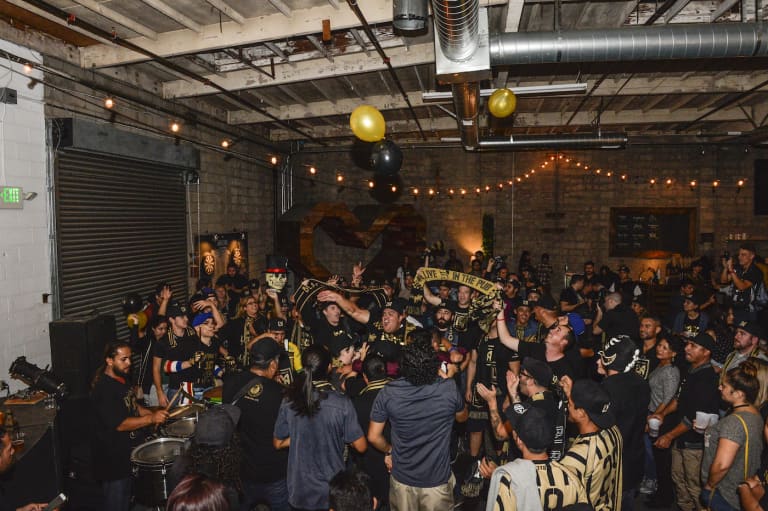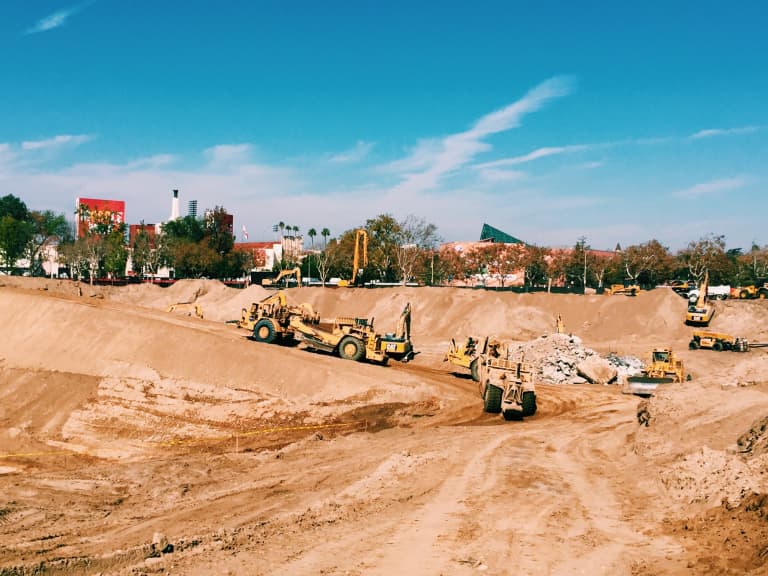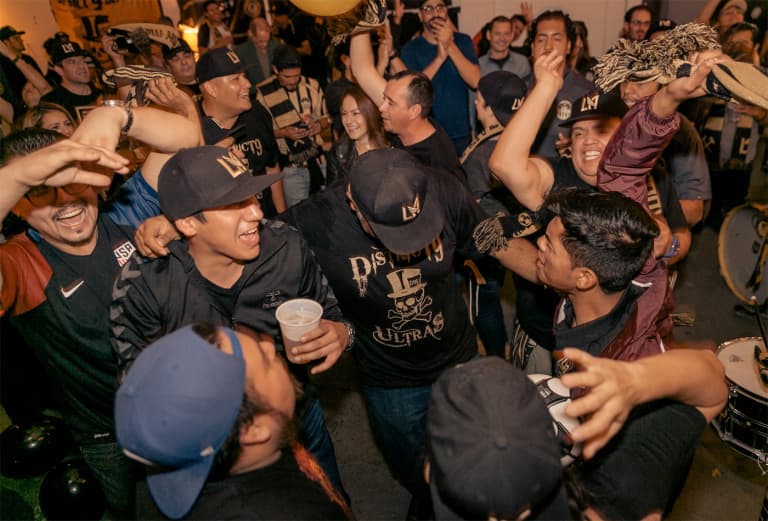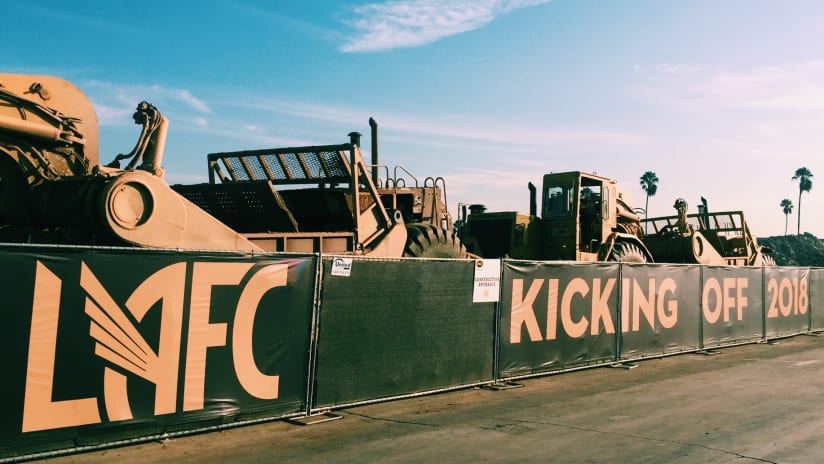This past weekend more than 500 LAFC fans, many representing in the team’s distinctive black-and-gold color scheme, enthusiastically gathered in a downtown Los Angeles brewery. The rally meant to celebrate two years since the club’s announcement, and the fact that it centered on supporters was appropriate. As LAFC has built from complete scratch, they’ve involved supporters in every aspect from day one.
And the team already enjoys a number of organized groups along for the ride. Take the LAFC Luckys, who started life as a Premier League-loving band of soccer fans gathering at a Pasadena pub in the mid-1990s and have now pledged allegiance to the black and gold.
Black Army 1850 and District 9 Ultras, meanwhile, both began as Chivas USA supporters’ groups. And as they wait for LAFC to start league play in 2018, they’ve already reemerged as full-fledged fans. Along all of these, too, come new groups like the Expo Originals, LAFC Relentless, and LAFC Cuervos.

LAFC supporters at the Nov. 5 rally; photo by Idris Erba
And while they wait for the team to start play in 2018, these supporters aren’t waiting idly — they’re actively influencing plenty of developments. Specifically, the LAFC front office is involving supporters’ groups in designing the Banc of California Stadium’s north end, where the team’s multiple supporters’ group will gather in a 3200-capacity section of the 22,000 seat stadium.
(For more about the current stadium site -- with photos -- click here.)
And they’re not just actively asking supporters what they’d like to see in their section. They’re sharing initial design plans with them, up to and including virtual reality headsets that show vivid 360-degree stadium renderings from a within-the-stadium perspective.
They’re also allowing supporters to meet with the architects designing the stadium, and articulate their visions for the section. That includes every aspect of the game-day experience, including where they’ll enter, where they could potentially rig tifo, and what goes into the bar built into the section, too.

The site of the future LAFC supporters' end; photo by Arielle Castillo
According to LAFC’s senior vice president of culture and community, Rich Orosco, involving the team’s most visible fans is the first step in an important, ongoing relationship between the front office and the supporters.
“This is going to be our home together, from the owners on down, and we want to make sure our supporters are involved,” he says. “When we were working on our club identity, we had in-person and online dialogues with them. This all speaks to the philosophy of our club. We know that players may come and go, but we’ll have our supporters for a lifetime.”
Patrick Aviles, the supporters relations’ front office representative, adds, “We’re building the stadium with them, not just for them.”
Working directly with supporters in designing their section isn’t unheard of in MLS. Portland Timbers owner Merritt Paulson worked closely with Timbers Army when he took over the team to reinvent the North End at Providence Park. Early league GMs like D.C. United’s Kevin Payne and the Chicago Fire’s Peter Wilt worked closely with supporters’ groups to help them define their sections.
But LAFC is aiming to take things up a level. In choosing Los Angeles-based stadium architects from Gensler to create LAFC’s new home, the front office kept it local. “I think it’s important to the project that we live here, and we’re heavily involved in the community,” said Gensler’s Jonathan Emmett, design principal for Banc of California Stadium.
“It was very important to the club from the beginning that fans were involved,” he adds. “LAFC is building a fan base from scratch, and so we’re thinking about not just how we can create a physical structure. We’re thinking about the fan’s experience in a very deliberate way.”
The conversations have brought forth a few surprises. The architects proposed an entrance gate that would be geared specifically for a supporters’ march from outside the stadium, and exclusive to them. They liked the idea of the gate, but didn’t want to prohibit other fans from utilizing that entrance.
The supporters also made it clear that the bar being created in the supporters’ section shouldn’t be exclusive to just them. They see its potential for helping sway newer fans to become regular, devoted supporters.
“All LAFC’s wanted to do from the outset is develop its fans, and we’re being let in through the front door to do this,” said Josef Zacher, one of the leaders of Black Army 1850. He finds that the architects and front office are receptive to what the supporters are suggesting, be it a pulley system to allow for more elaborate tifo, or local craft beers in the supporters’ bar.
One important discussion that is still ongoing involves safe-standing zones. The design of the LAFC supporters’ section is inspired in part by Borussia Dortmund’s Westfalenstadion. That venue’s “yellow wall” is being invoked by those actively creating safe supporters’ zones in new stadiums, and those who see them as the future.
The north end section of the Banc of California stadium offers what Emmett calls “the steepest grade allowed by code” at 34 degrees, and with the lip of the section just 12 feet from the field, it has the potential to be quite loud. And though a safe standing zone makes sense to the supporters, the architects are also considering non-LAFC events at the stadium, including FIFA-sanctioned matches (where all ticketholders must have seats) and concerts. The architects do note that there is an option they’re exploring, in which north end seats could be removed for LAFC matches and replaced with the rail seats that keep the safe standing zones safe.
The supporters, meanwhile, are continuing to grow, gather, and practice chants in anticipation for the debut 2018 season. They’re musing over potential players making up the initial squad; Zacher says the Black Army’s been fancifully dreaming about the likes of Cristiano Ronaldo, Mesut Ozil, and Chicharito donning the black and gold, though some also want to see U.S. national players find a home in L.A.

Another scene from the Nov. 5 LAFC rally; photo by Imad Bolotok
No matter who makes up the squad though though, the fans anticipate a joyous supporters’ culture from a still-growing number of groups that borrow from and expands on multiple influences from around the world.
Julio Ramos, from District 9 Ultras, promises an update to the Barra-style support they brought to Carson as the Union Ultras, starting with the name change to reflect the part of the city where the new stadium is. “There are some people who already clowning us for the movie” of the same name, he says, but notes that they’re owning, and even liking, the association.
Sal Reyes, from LAFC Luckys, wants English-style support. “What’s missing from MLS is spontaneous chants that come from the run of play,” he says, as well as songs that herald specific players when they sub on and off or do something noteworthy. He also notes, however, that the Luckys are about “having a pint and a laugh at the end of the day.”
And the Black Army, according to Zucher, notes that they’re drawing from Germany and South America, with a mix of English- and Spanish-language cheering. “We just want active support,” he says. “It it’s loud, it’s good.”













